Art World
Why Is Cake (Yes, Cake) Suddenly Omnipresent in Contemporary Art? An Investigation
A comprehensive history of cake and how it became one of the favorite artistic symbols of our jaded generation.
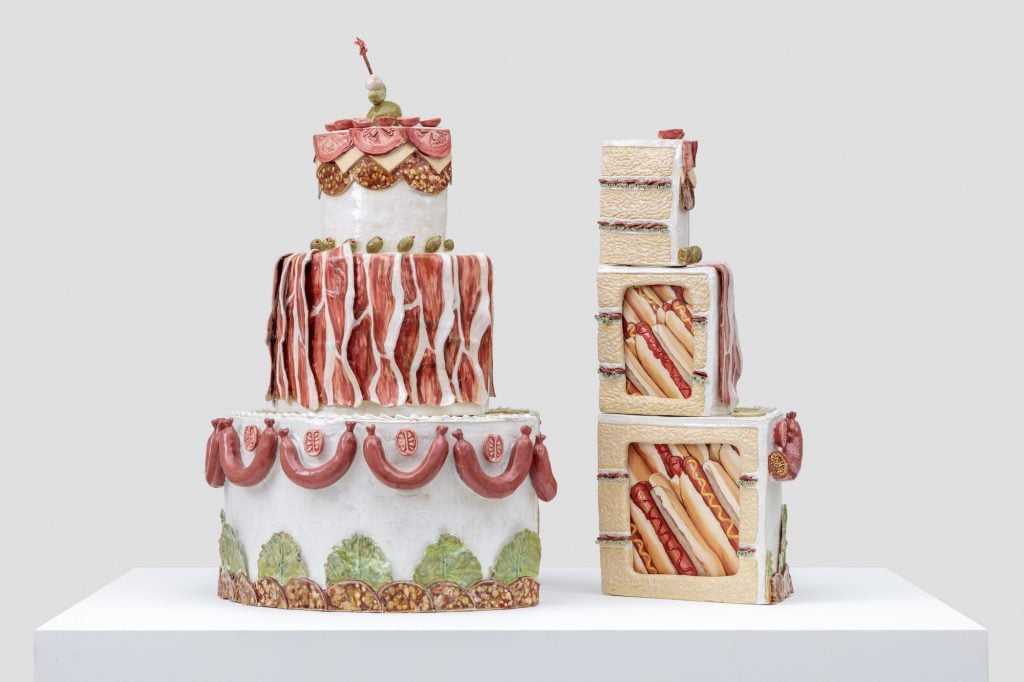
A comprehensive history of cake and how it became one of the favorite artistic symbols of our jaded generation.

Katie White

Nothing is real, everything is cake.
Those are the auspices behind a current cultural phenomenon: trompe l’oeil cakes. In viral internet videos, everyday objects—a microwave, a pair of shoes, a sandwich—are, with the fall of a sharpened knife, revealed to be sugary confections made of layers of cake, fondant, frosting, jammy filling.
Trompe l’oeil is a term traditionally used to describe an illusionistic style of painting, one that deceives the eye into wondering if artifice is real. Such deceptive depictions are often regarded as a testament to the talents of the artist. Mischievous art historical tales abound. Birds were said to have pecked grapes painted by the ancient Greek artist Zeuxis. George Washington, according to lore, tipped his hat at Charles Willson Peale’s portrait of his sons, Raphaelle and Titian Peale, ascending a staircase. Giotto painted a fly so realistically that his teacher, Cimabue, tried to swat it away, Vasari tells us.
TALK ABOUT TRIPPY ??
Follow Red Rose Cake and Tuba Geçkil on TikTok for more: https://t.co/9ka07T98cI pic.twitter.com/BCUg0ALwpI
— Food Network (@FoodNetwork) February 1, 2022
While paintings have long engaged viewers in the unique pleasures of such visual puzzles, we seem to have entered a brave new world of cake as art. Though hyper-realistic desserts have been around for years, the recent experience of quarantine and the resulting online immersion seems to have whet our collective appetite for these illusionistic confections.
The cakes really took off in July 2020, when Buzzfeed’s “Tasty” account posted a video showcasing the mindboggling sculptural cakes of Turkish baker and self-proclaimed cake artist Tuba Geçkil. The post launched the meme sensation #everythingiscake, which still has not fully abated. Just this month, Netflix is launching Is It Cake? a new show based on this very premise—that everything we see may, in fact, be dessert.
The New York Times, too, has delved into cake decorating trends that range from the illusionistic to the whimsical to the downright messy.
Artists are not, of course, immune from such sugary allures. Many of these internet-famous cake creators are artists who have either found cake to be their ideal medium or who decorate cakes while keeping distinct artistic practices.
The artistic fascination with cake is nothing new, entirely, we realize. The late American artist Wayne Thiebaud, the beloved painter of pastel confections, left a legacy of more than a half-century of painted cakes.
Marie Antoinette has finally been uncancelled after everything actually turned out to be cake
— dorku (@Dorkstar) July 12, 2020
But there’s no denying a vogue for cakes is underway in the art world. Way back in 2017, Mrs. Gallery in Maspeth, Queens, first explored the burgeoning phenomenon in the group show “Cake Hole” which linked cake in contemporary art to cultural evolutions across the millennia. Last December, Baba Yaga Gallery in Hudson, New York, hosted “Where Nothing Is Dripping: An Exhibition of Cakes,” which brought together cakes-as-art by decorators Madeline Bach (@frostedhag), Alli Gelles (@cakes4sport), Hannah Mendel (@forsythia_forsythia), and Billie Belo (@cakes_for_no_occasion), who calls her work “Abstract Expressionist cake experiences.”
In January, the Pit Gallery hosted “Cake Show,” which brought together artworks that grapple with the sociopolitical symbolism of cake, which curator Thea Smolinski described as “Less ‘let them eat cake’ and more community bake sale.”
So, what’s with all the cake? And what does any of it mean? Below, we take a closer look at the phenomenon.
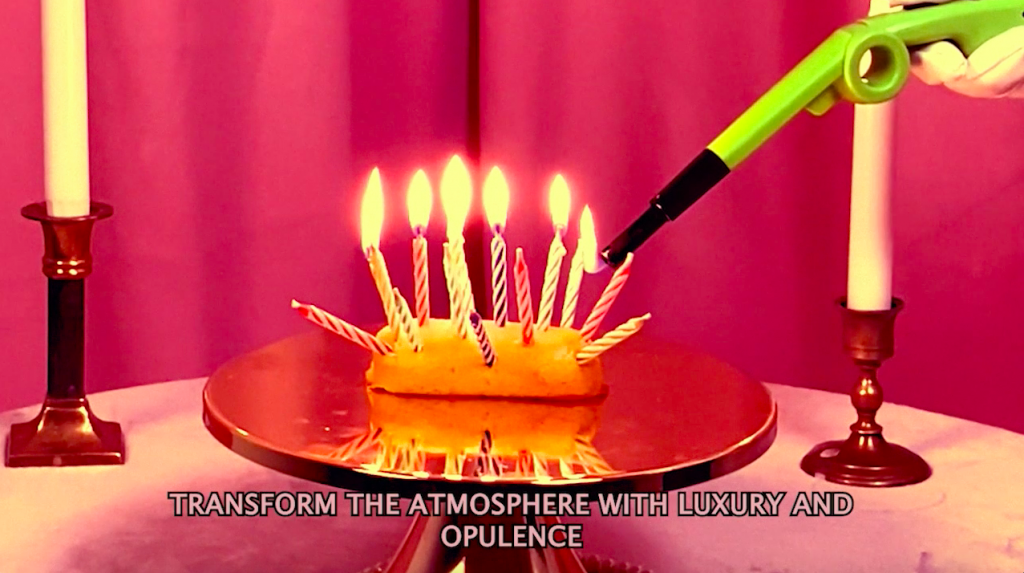
Sydney Shavers, Summerscents_20Purrls_with_OACHAVE. Courtesy of the artist.
Let them eat cake: one of the most notorious quotes in history is one that is probably apocryphal. As popular history goes, in 1789, upon learning that her subjects lacked even bread, Queen Marie Antoinette was said to have quipped Qu’ils mangent de la brioche or “Let them eat cake” (or brioche, if we’re being accurate). The remark, seemingly encapsulating the callous extravagance of the monarchy, stoked the flames of a revolution that would ultimately cost the queen her life.
Truth be told, versions of the “let them eat cake” tale had been circulating in France for more than a century; an earlier iteration of the quote had first affixed itself to Marie-Thérèse, a Spanish princess who had married King Louis XIV in 1660. It was only some 50 years after Antoinette’s death that tales of the infamous retort would begin to circulate.
Despite its dubiousness, the quote does hint at a truth about cake in the 18th century—it was a decadence reserved for the very rich. The origins of cake are complex with different versions of sweetened pastries originating in ancient Egypt, Greece, Scandinavia, and many others cultures. Nevertheless, well into the 19th century, many of the foundational ingredients of cake as we know them today—sugar, chocolate, fruits, and to some degree milk and fat—were luxuries in Europe reserved for the very rich. The ingredients were also inextricably linked to colonial exploits in the New World and, inevitably, to slavery.
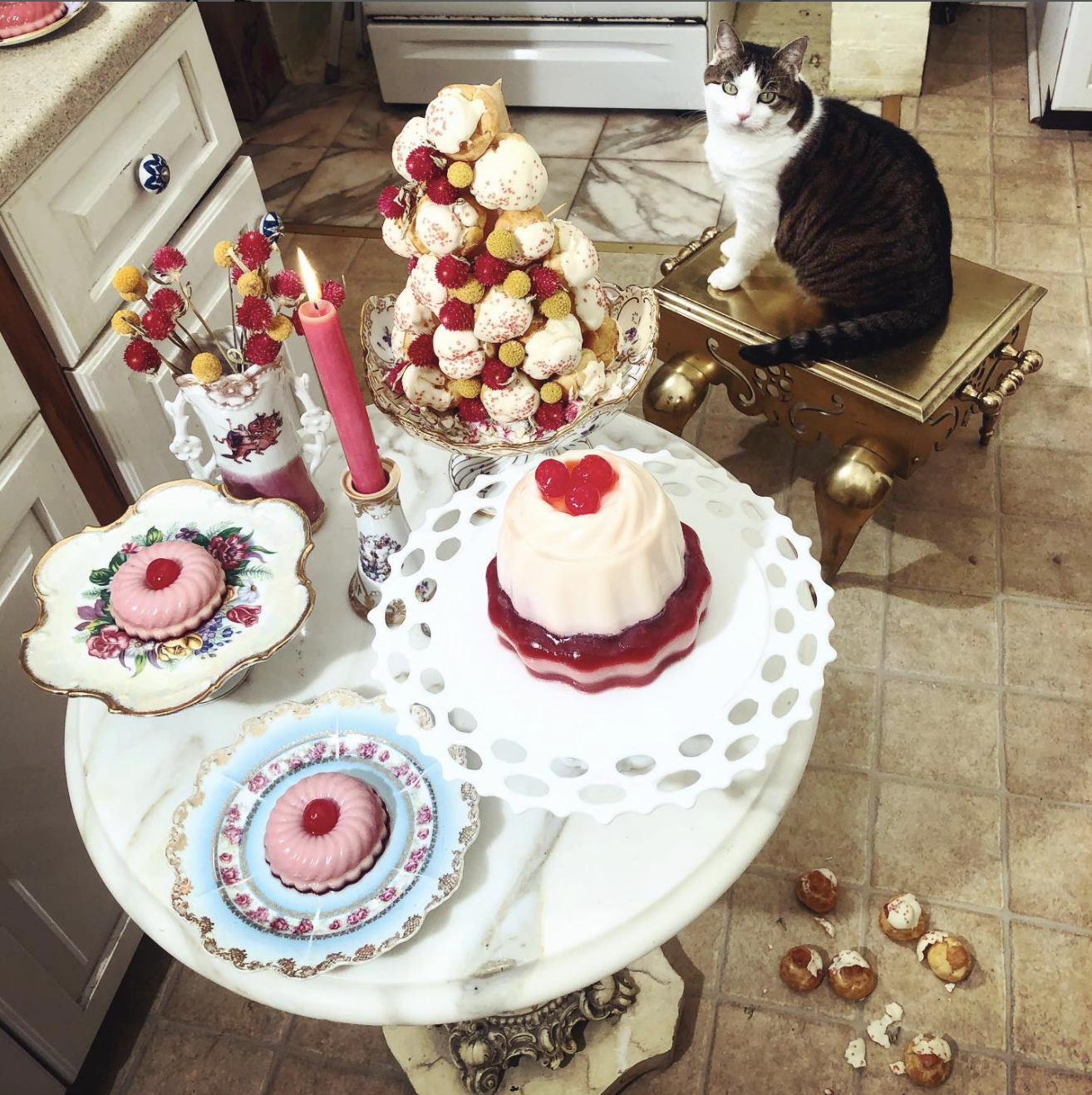
Courtesy of Anna Cone.
During the past two years, artist Anna Cone, who is based in Newburgh, New York, has incorporated her personal pleasures—baking, cooking, hosting, and entertaining—into her practice with an awareness of cake’s darker origins. In the spring of 2020, Cone was feeling stuck in her work and thought that the sudden popular resurgence of baking might be a way to connect to others online.
“I found a set of mini Jello molds at an estate sale and decided to make Jello in them for fun and was immediately enamored by the material,” said Cone, whose practice involves witchcraft. “I was working on binding spells at the time, and it just clicked as the perfect binding material. The material is soft and ephemeral, which limits my power. I see these spells as a co-creation: if the spell is meant to hold it will congeal and release, but if not the delicate material will crack and the figure can break free.”
Cone’s sugary creations simultaneously acknowledge and explore the historical realities of the ingredients in cakes and confections. “The increasing European demand for sugar fueled slavery in America, the West Indies, and many other tropical colonies,” she said. At the same time, as sugar became accessible to the working class, it lost its power as a symbol of wealth.
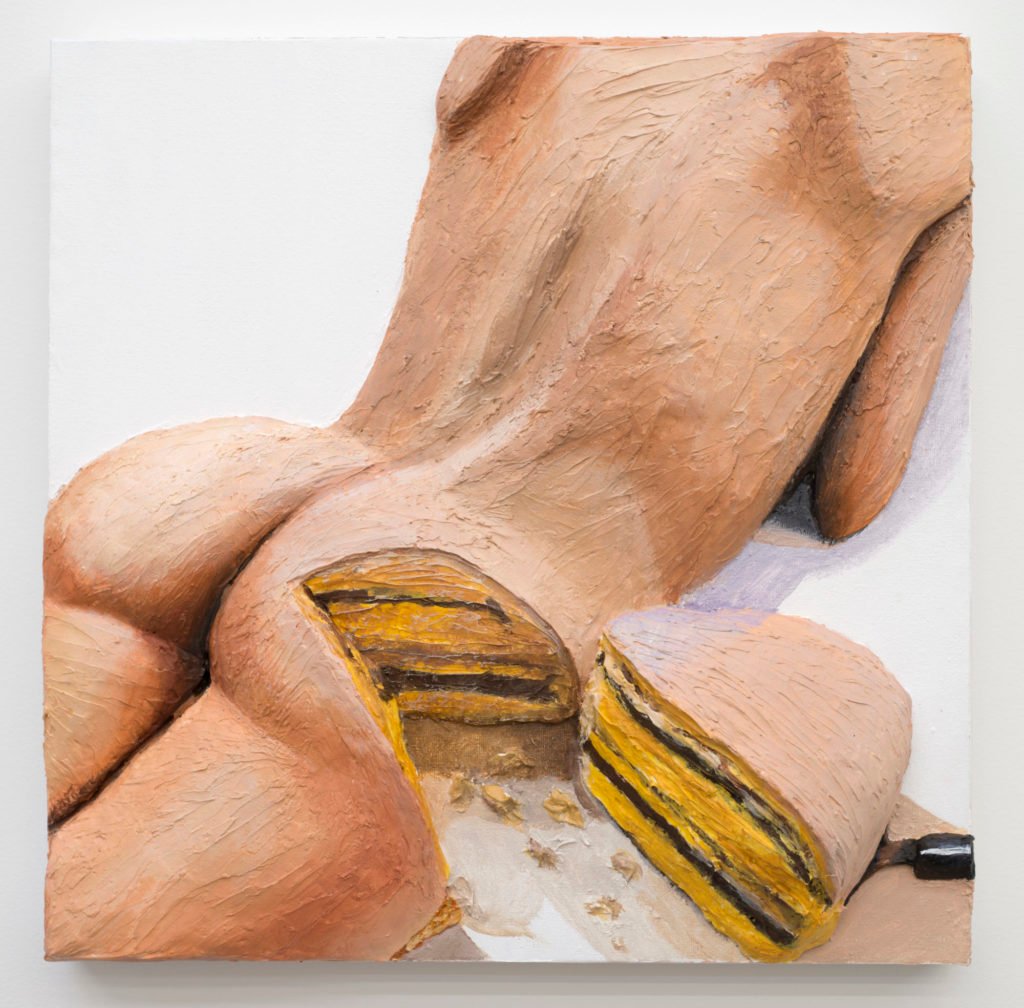
Gina Beavers, Cake (2015). Courtesy the artist.
“Sugar also links to modern capitalism because, like coffee and tobacco, it is a stimulant for workers, so the enslaved people of the colonies were fueling the growth of capitalism in Europe,” Cone added.
Meanwhile, Brooklyn-based artist Sydney Shavers incorporates cake as a symbol in her paintings and internet-based works as a means of exploring how sugar has become associated with the female body and ideas of femininity.
“I have been thinking a lot about how celebrity perfumes are known for being sickly sweet to the point that Jessica Simpson launched a line of ‘tasteable’ dessert body treats in the early 2000s,” she said. “There is a desire to see the feminine as these saccharine adorned beings and ignore the very real depth that also exists. Sugary pink femininity is amazing but there are so many other ‘notes’ that go missed when we limit a concept to just that representation.”
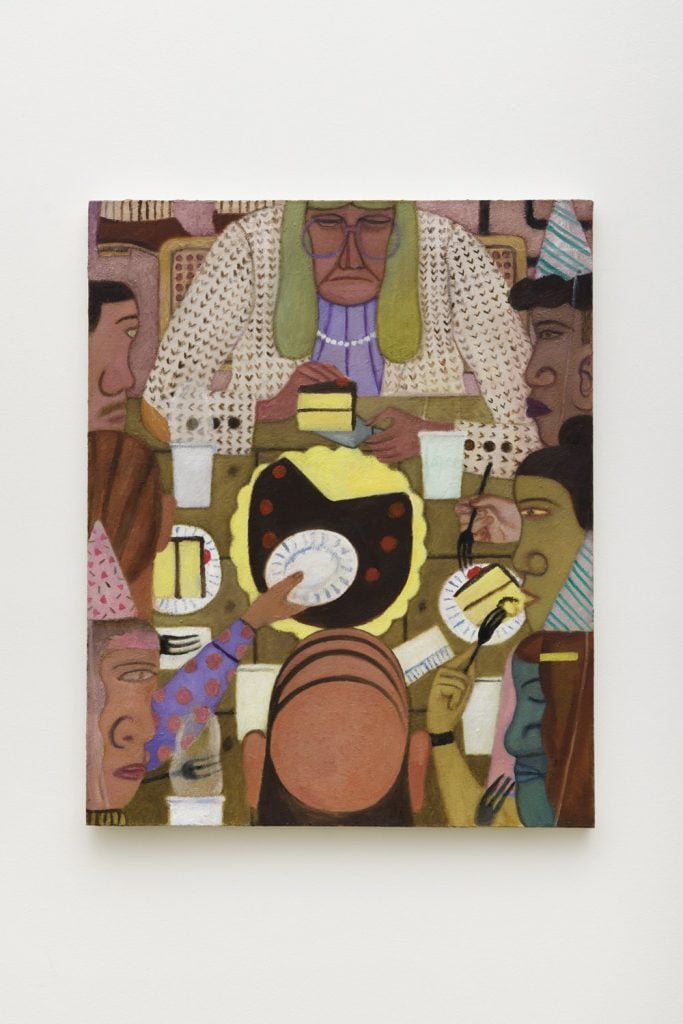
Nora Riggs, Work Cake (2021). Courtesy of the Pit.
What does it mean to us, for instance, if a cake is store-bought or homemade?
Once beyond reach for all but the very wealthy, by the early 20th century cake had become commonplace for even the smallest occasions. As sugar became more widely available in the 19th century, cakes began showing up in middle-class households, and by the 1920s they were everywhere. With this shift, cake began to take new connotations, distinct from its associations with luxury and power, and more closely linked to notions of domesticity and the modern woman.
The exhibition “Cake Show” at the Pit Palm Springs was organized around this premise.
“This is a cake show, but it’s also a show about gender and labor and networks,” said Smolinski, the curator of the show. “I think the ambivalence of the metaphor of cake is very much part of what makes the show so exciting for me: It is so silly and decadent and feminine, but it also really couldn’t be less frivolous. That in and of itself is so intrinsic to our social experience, making these quite serious things appear pretty and palatable.
Here, cake becomes more a metaphor for the ways women’s often unacknowledged labor underpins society. In the painting Work Cake, artist Nora Riggs depicts an office matriarch doling out slices of cake to coworkers, a scene far from the glitz of the Versaille court.
“You know immediately which woman organized the gathering, and you know exactly what place she holds in the office hierarchy,” Smolinski said of the painting. “Cake there becomes a really crucial metaphor for the ways in which women inhabit and literally uphold the structure of an organization without being allowed to wield any hard power.”
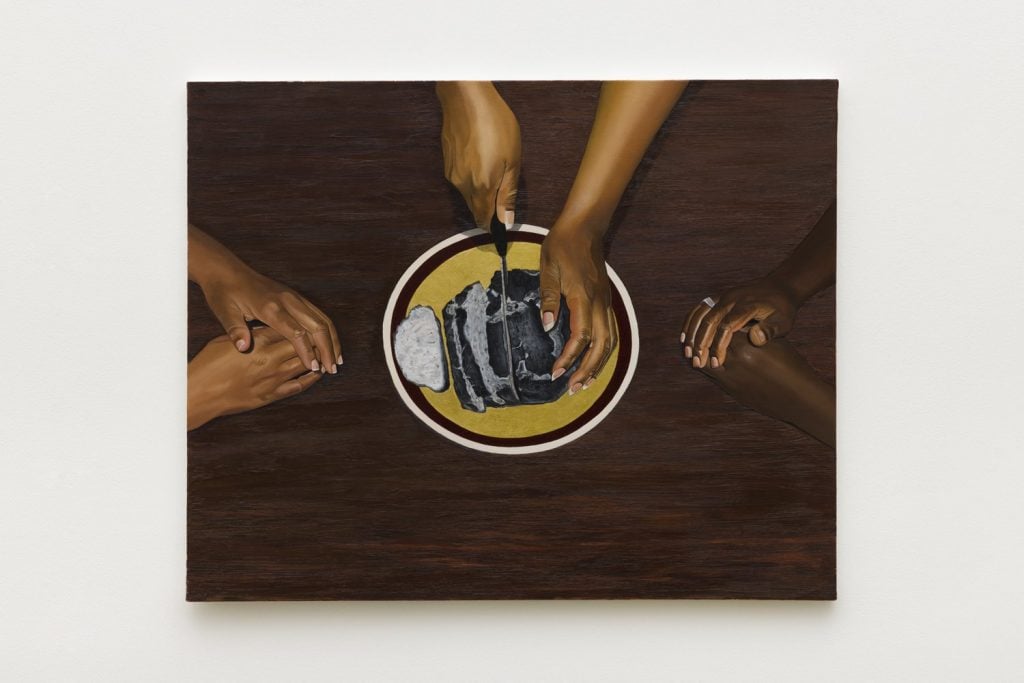
Shantel Miller, Bread of Life (2021) Courtesy of the Pit.
The cake here is the stuff of daily labor. In Shantel Miller’s painting Bread of Life, we see a woman’s hands slicing a loaf of bread or cake, as two other sets of hands, rest, waiting. Without explanation, we understand that the hands slicing the cake belong to a mother. In Victoria Nunley’s But This Cake Is so Wonderfully Moist! (2021), a woman in a power suit doles out a slice of cake at a picnic, her energy almost manic, depicting the overextended reality of “having it all.”
“I think the ugly cake trend is super fascinating,” said Smolinski. “It feels like progress in that we’re finally allowed to be (a little) messy or unattractive but also: anyone who’s ever watched the Great British Baking Show knows good cake is technically really difficult. So even when it’s ugly it still has to be essentially perfect. If that’s not a metaphor for 21st-century womanhood, I don’t know what is.”
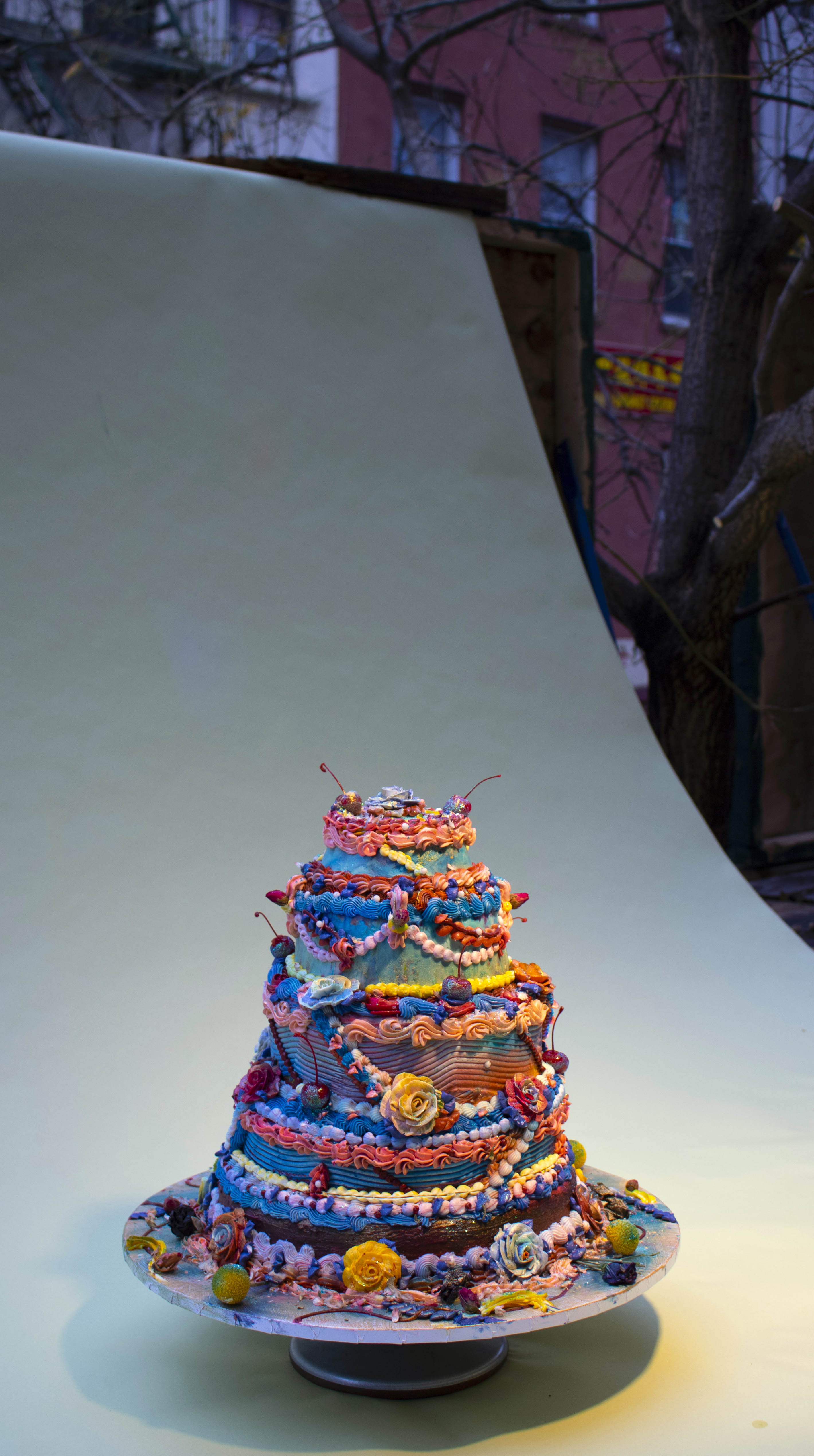
Courtesy of Madeline Bach.
For some artists cake is a symbol, for others, cake is the medium itself. The past two years have given rise to an internet class of cake decorators who consider themselves artists or who are artists with fine art practices, who simultaneously decorate cakes.
Among these cake influencers is Alli Gelles, a sculptor who started baking nontraditional, often biomorphic cakes and posting them at @cakes4sport. For Gelles, cake seemed like a foil to the permanence of her ceramic sculptures.
“Cake is ephemeral: you must consume it to fully experience it, and then it’s gone,” she said in an email. “Its temporality subverts institution and collection. The juxtaposition of ceramic and cake in my art practice is an exploration of permanence and impermanence—and for me as an individual, what’s worth creating in the midst of our climate crisis?”
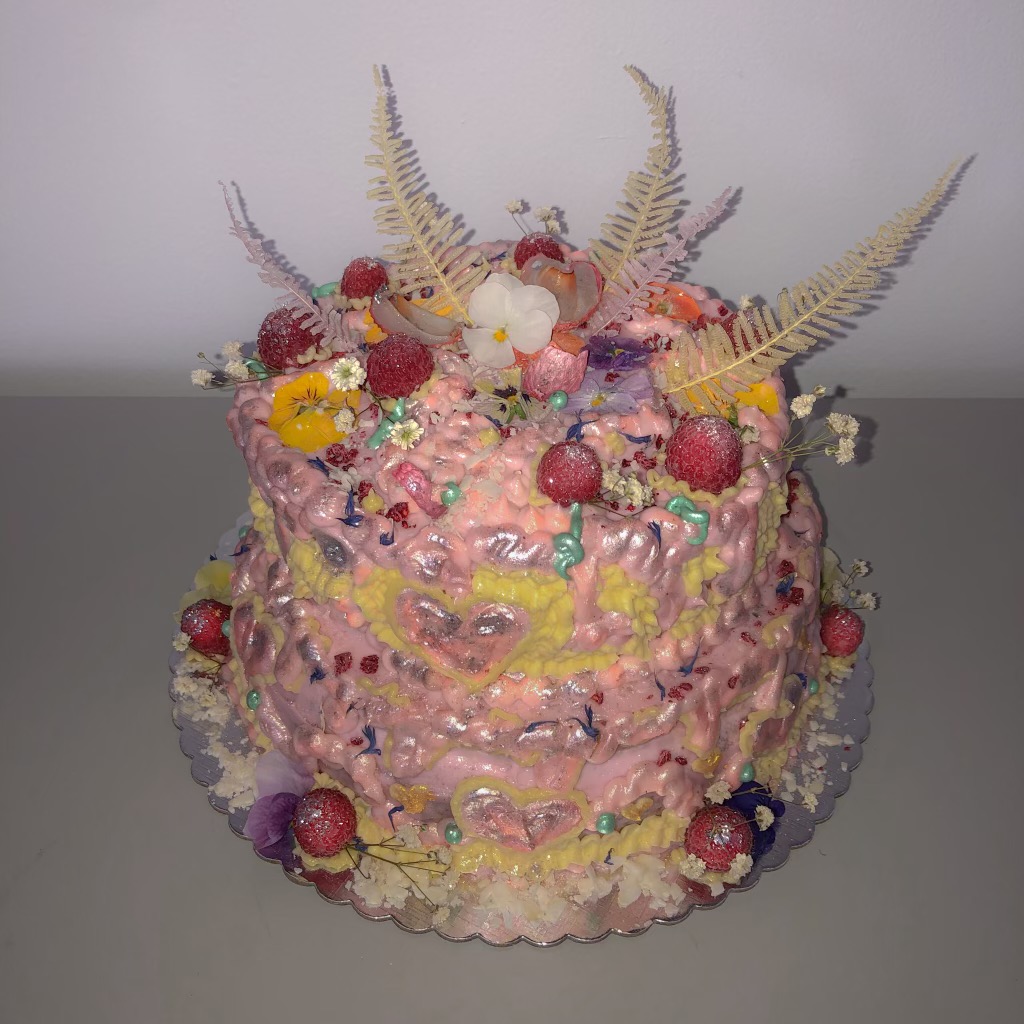
Courtesy of @cakes4sport.
Gelles sees the phenomenon of cakes-as-art as at once internet based and community oriented. “The internet is fascinated with messes. My cakes look like something anyone could make—because they are,” she said. “Like so much that is dismissed as ‘craft’ rather than ‘art’, baking has long been an arena of knowledge sharing. And what could be easier for an art world gatekeeper to scoff at than something that’s for everyone?”
“Within an art world that operates on the myth of false scarcity and competing for resources, sharing is radical,” said Cone.
Others see cake as the perfect medium for pushing back against its own gendered associations. “I don’t see myself as someone inherently feminine,” said Hana Betakova, the baker behind @rustcakes whose cakes seem pulled from a disquieting fairytale. For Betakova, cake ought to be freed from old conventions. “The most important thing is that I can be creative. In my work, I’m interested in the aesthetics of contemporary culture, medievalism, and nature. Cake doesn’t have to be feminine or masculine. It’s food.”
Madeline Bach, an artist and decorator behind the popular cake account @frostedhag, worked in a bakery throughout her undergraduate degree. Only after years did she earn the right to decorate cakes. Bach is adamant that her fine art practice, which focuses on portraiture, informs and is informed by her cakes.
“When I’ve been met with a condescending response about cakes being a very real extension of my art practice (almost always from people who have never lifted a finger in a kitchen) I’m reminded of how much work goes into this and into defending it as an art form,” Bach said. “But the focus, time, effort, and skill is just as much if not more than what goes into a lot of contemporary art-making. To me, the parallels are obvious. I’m thinking about color, composition, form, and I’m working with oil (butter!) and a palette knife! And a brush! If cake as art is silly or cringe or cute then so is all painting.”
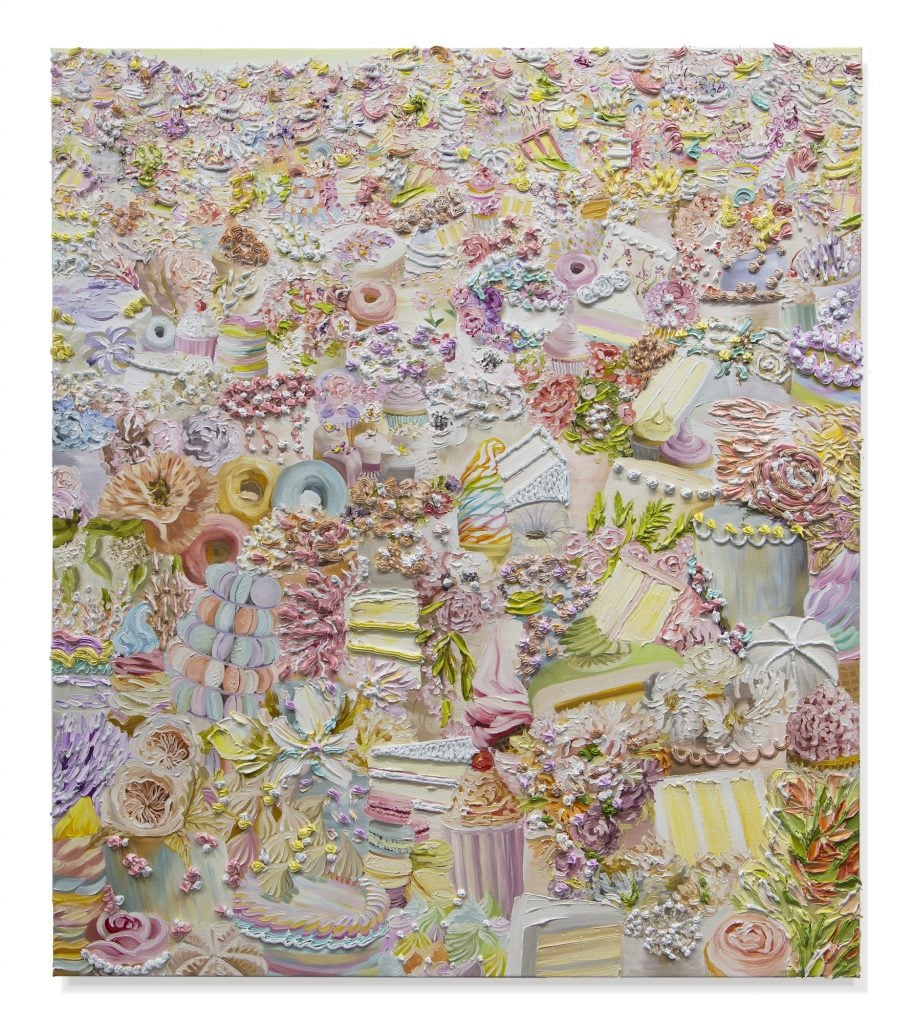
Christina Nicodema, Freakshake Mountain, Soft Rainbow (2022). Courtesy of the artist.
One characteristic of cake in the age of the internet is that our consumption is visual rather than gustatory. In the case of trompe l’oeil cakes, some bakers have noted that fondant, the primary ingredient for constructing these hyper-realistic cakes, tastes… actually pretty bad.
“Cakes have been becoming more and more realistic and elaborate, and it has something to do with their visual appeal for Instagram, but let me tell you—fondant tastes like crap,” said baker Nitash Lalkaka of Patisserie Nitash.
Many artists depicting cake today are interested in the tension between pleasure and repulsion, visual consumption, and physical denial. Artist Stephanie Temma Hier, who has garnered growing attention for her surrealist ceramic sculptures of food, wants her works to operate in this push-and-pull of pleasure and revulsion.
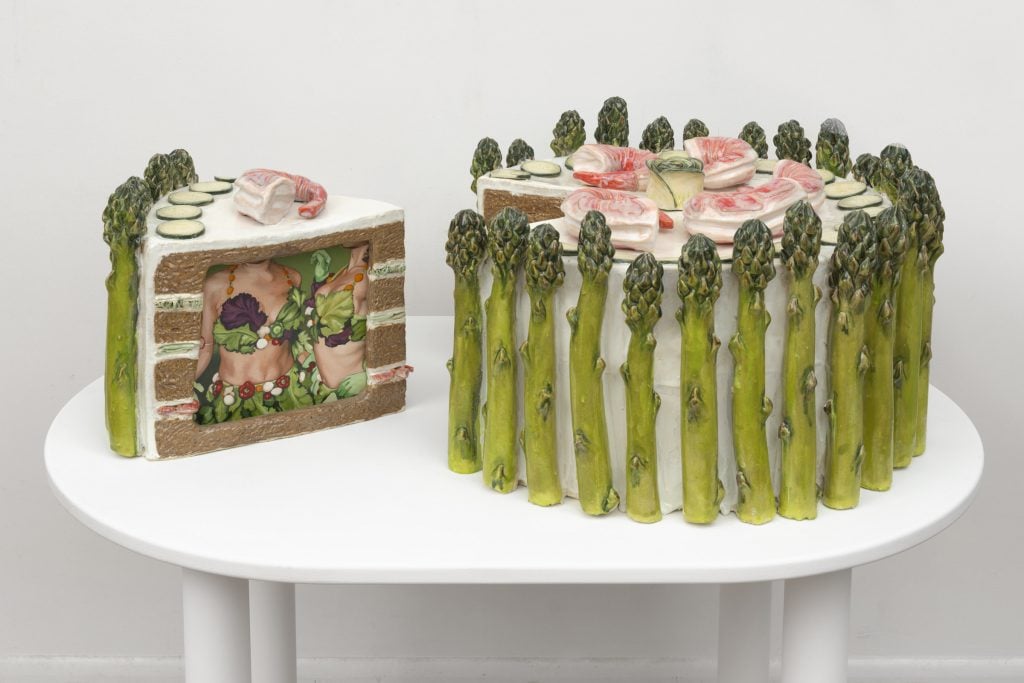
Stephanie Temma Hier, Real food for pretend chefs (2021). Courtesy of the artist and Bradley Ertaskiran Gallery. Photograph by Lance Brewer.
“The idea of a cake is so laden with connotations of pleasure, decadence, and frivolity. But the surfeit of that pleasure quickly brings about the grotesque feeling of overindulgence,” she said. “I think I first became aware of this dual nature with that legendary cake-eating scene in the movie Matilda. My own cake sculptures kind of play with that duality, making cakes that are both beautifully decorated but are actually quite off-putting in their ingredients.”
The internet underpins many conversations about the meaning of cake in art. New York artist Cristina Nicodema has spent years painting canvases filled with mountains of cakes covered in pastel icings. Her works explore human consumption and how it relates to the stability of the environment.
When we spoke, Nicodema introduced me to the “freak shake,” a viral trend of posting milkshakes laden with elaborate sweetened concoctions, mounds of whipped cream, towering with doughnuts, cookies, brownies, and heaps of sprinkles. Even pieces of bacon.
“It is about being the most grotesque display of excess, and it exists to post on Instagram essentially, and be consumed that way. I use ‘freak shake’ as titles in my works because it speaks to that ridiculous internet behavior and the pinnacle of grotesque food pornification.”
Sugar, Nicodema said, was her “first drug of addiction.”
“We all have experiences of addiction: the internet, our phones, social media, food, sex, and substances. We live in a very excessive culture and our relationship with food is feast or famine. We’re obsessed with food, take pictures of it all the time and blast it on the internet. Simultaneously we also live in a diet culture, focused on denial. It’s fetishistic.”
Nicodema thinks cake is a metaphor for reckoning with a culture in crisis.
“Lately, my paintings have been getting thicker and more heavily painted in a way that references the piping of a three-dimensional cake,” she said. “These paintings are about the glory and tragedy of our civilization. We would not have time to decorate a cake or let alone think of one without the collective safety created by civilization. Civilization is at its peak just as it’s about to topple.”
Other artists, too, hint at this aura of Baroque decadence and decline. Considering trompe l’oeil cakes, Shavers remarked, “People cutting into walls or basketballs or Telfar bags or watermelons that are actually cake felt like the real cultural residue of our collective existential dread. We all fully delved into our fascination with things not being as they appear.”
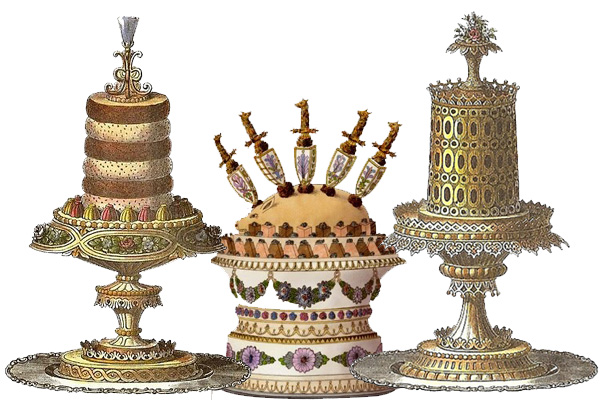
Marie-Antoine Carême’s designs for his famous pièces montées.
Still, the excess and artifice of cake go back centuries. In the late 18th century, French pastry chef Marie-Antoine Carême grew increasingly famous for his pièces montées, elaborate, often architectural designs made with sugar, marzipan, nougat, and pastry that were sometimes several feet tall.
Carême regarded pastry as the most important of the arts, above painting, sculpture, music, architecture, and poetry. His sugary creations took inspiration from global antiquity—Roman temples, pyramids, and other ancient ruins he saw in architectural history books. So elaborate and popular were his pastries that he even earned the attention of Napoleon. But Carême’s concoctions were not known for their taste, in fact, the pièces montées were not meant to be consumed at all. Their purpose was to delight the eye in a game of looking and looking again.
Which isn’t such is a purposeless endeavor. “If people feel something isn’t worth a second look, it’s because they think they understood it the first time,” Shavers said. “Luckily, art analysis requires us to examine on a deeper level, and first impressions start to fall by the wayside. If a simple concept like cake can bring all these other questions and realities into the picture, maybe we’ll wonder what else are we as a society overlooking.”